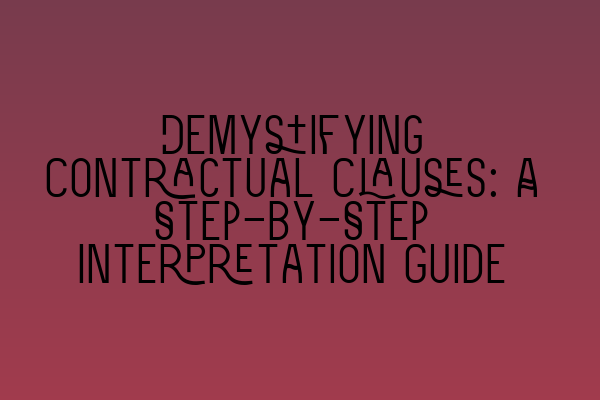Demystifying Contractual Clauses: A Step-by-Step Interpretation Guide
Contracts are a fundamental aspect of business and legal transactions. They establish and govern the rights and obligations of the parties involved. Within contracts, various clauses are used to address specific issues and protect the interests of the parties. However, understanding and interpreting these contractual clauses can often be a daunting task.
In this guide, we will demystify contractual clauses by providing you with a step-by-step interpretation process. By following these steps, you will be able to navigate through complex contract language and gain a clear understanding of the rights and responsibilities established within each clause.
Step 1: Read the Clause Carefully
The first step in interpreting a contractual clause is to thoroughly read the clause in question. Take your time to understand the language used, paying close attention to any defined terms, specific obligations, and any conditions or limitations outlined.
While reading, it’s essential to consider the context of the entire contract and how the clause fits into the overall agreement. This will help you establish the purpose and intention behind the clause, making it easier to interpret its meaning.
Step 2: Identify Key Terms
Once you have read the clause, it’s crucial to identify the key terms used within it. Key terms are specific words or phrases that have a significant impact on the interpretation of the clause.
For example, words such as “shall,” “may,” or “must” can indicate different levels of obligation or permission. Defined terms within the contract should also be identified and understood in their context.
If there are any ambiguous terms or phrases, it may be necessary to refer to the definitions section of the contract or seek legal advice to clarify their meaning.
Step 3: Consider the Purpose and Intent
Every clause within a contract serves a purpose and is intended to achieve a particular outcome. Understanding the purpose and intent behind the clause is crucial in interpreting its meaning accurately.
Consider the broader objectives of the contract and how the clause contributes to achieving those objectives. This will help you determine the scope and effect of the clause and any underlying principles guiding its interpretation.
Step 4: Evaluate the Surrounding Clauses
Contracts are not solitary documents; they are composed of multiple clauses that work together to establish a comprehensive set of rights and obligations. Evaluating the surrounding clauses is essential in interpreting the meaning of any particular clause.
Look for potential connections between the clause you’re interpreting and other clauses within the contract. Consider whether any other clauses shed light on the interpretation or provide additional context.
Step 5: Examine Relevant Case Law
Legal principles established through previous cases, commonly known as case law, can provide valuable guidance in contract interpretation. If there is ambiguity or uncertainty surrounding a contractual clause, it is helpful to research and examine relevant case law.
Case law can provide insights into how certain clauses have been interpreted in similar contexts, helping you understand how courts may interpret the clause in question if a dispute were to arise.
Unveiling Real-Life Case Studies: Insights into Legal Practice and Decision-Making
Step 6: Seek Legal Advice if Needed
Interpreting contractual clauses can be complex, and in some cases, the assistance of a legal professional may be necessary to ensure accurate interpretation. If you encounter difficulties or uncertainties, it is advisable to seek legal advice.
Experienced solicitors can provide expertise and guidance, taking into account the specific language and context of the contract, as well as any relevant industry practices or standards.
Remember, contract interpretation is an essential aspect of legal practice, and proper understanding can help avoid disputes or disagreements down the line.
Exploring Solicitor Salaries in the UK: Average Earnings and Factors Affecting Income
Conclusion
Interpreting contractual clauses may seem daunting at first, but by following a step-by-step process, you can demystify the language and gain a clearer understanding of the rights and obligations established within each clause.
By carefully reading the clause, identifying key terms, considering the purpose and intent, evaluating the surrounding clauses, examining relevant case law, and seeking legal advice if needed, you can confidently interpret contractual clauses and ensure compliance with the agreed terms.
For more information on legal practice and decision-making, check out our article on “Unveiling Real-Life Case Studies: Insights into Legal Practice and Decision-Making.”
Interested in pursuing a career as a solicitor? Learn about the average earnings and factors affecting income in our article on “Exploring Solicitor Salaries in the UK: Average Earnings and Factors Affecting Income.”
For aspiring solicitors, we have a comprehensive guide on “Pursuing a Law School Education in the UK: Choosing the Right Path for Your Future.”
Curious about securing training contracts? Check out our roadmap to becoming a solicitor in the article: “Securing Training Contracts: A Roadmap to Becoming a Solicitor.”
For support and mentorship in the legal field, read our article on “Mentorship for Aspiring Solicitors: Nurturing Talent in the Legal Field.”
